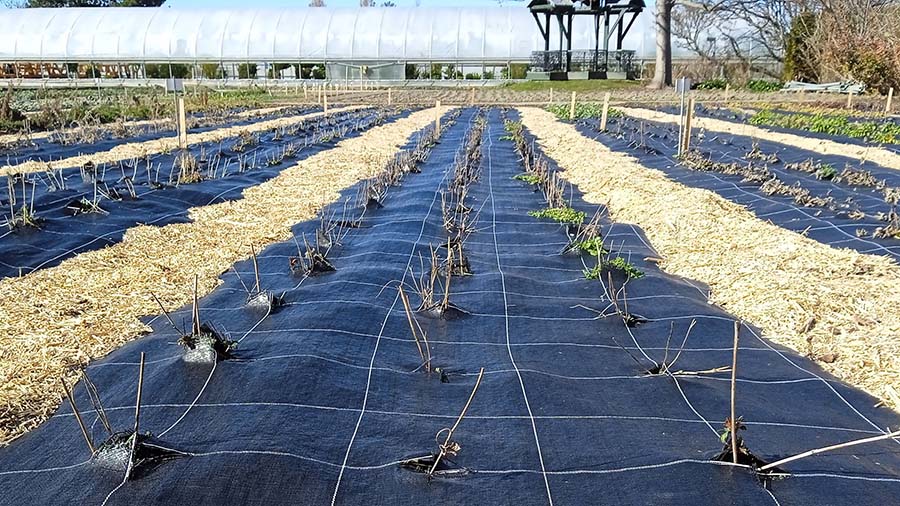Weed Warrior: How Slit Film Woven Geotextiles Effectively Block Weeds
The primary power of woven landscape fabric in your garden lies in its remarkable ability to suppress weed growth right at the source. Unlike chemical herbicides that target existing weeds or require repeated application, woven landscape fabric creates a physical barrier that disrupts the very conditions weed seeds need to germinate and thrive.
The tightly woven structure of the slit film polypropylene strands is key to this effectiveness. By creating a dense layer over the soil surface, the fabric blocks sunlight from reaching the weed seeds below. Sunlight is the essential trigger for the germination process for many common garden weeds. Without adequate light, these seeds remain dormant and eventually die off without ever emerging as the pesky invaders intent on taking over your garden.
Think back to the simple experiment we suggested in Chapter 1, where you covered a patch of weeds with cardboard or newspaper. The woven landscape fabric operates on a similar principle – it deprives weed seeds of light. However, unlike cardboard, it allows crucial elements like water and air to penetrate the soil, benefiting your desired plants.
Try This
Find a patch of bare (weed-free) soil in your garden where weeds tend to sprout readily. Pull as many of the existing weeds in this area as you can. Next, cover half of this area with a piece of woven landscape fabric and secure it with garden staples. Leave the other half uncovered as a control. Over the next week or two, observe the difference in weed growth between the covered and uncovered sections. You’ll likely notice a significant reduction, if not a complete absence, of new weeds sprouting beneath the woven fabric. This simple visual demonstration highlights the powerful weed-blocking capability of this material in action.
Strong and Durable
Okay, so it stops weeds – that’s a big win. But here’s another reason woven landscape fabric is a wise choice: it’s tough stuff! Think about wrestling with a roll of it – you’ll notice it doesn’t stretch out of shape easily or tear when you’re trying to position it. That’s because of the woven structure, like a strong outdoor rug.
This isn’t the kind of fabric that will rip the first time your trowel accidentally pokes it or get shredded by your dog running across the garden. It’s made to handle the real-world wear and tear of a busy garden. Plus, the material itself – that polypropylene – is like it has its own built-in sunscreen. Unlike cheaper options, it can handle the summer heat and strong sunlight without breaking down and becoming brittle. It also doesn’t get all weird and moldy in damp soil.
What does all this toughness mean for you? It means you won’t be replacing this stuff every year or two. Once it’s down, it’s down for the long haul, keeping those weeds at bay and even helping to keep your soil in place on slopes. So, while it might cost a little more upfront than some of the flimsier fabrics, think of it as an investment that saves you time, money, and a lot of hassle. It’s the kind of reliable workhorse you want in your garden arsenal.
Breathable and Beneficial
At this point, you might think, “If this fabric is so good at blocking weeds, does it also block the good stuff, like water and air, that my plants need?” That’s a crucial question, and the answer is a resounding “No!” This is where woven landscape fabric shines compared to solid plastic sheeting or other non-permeable barriers.
The key here is the woven construction. Tiny spaces between the interwoven strands act like a sieve, allowing water to pass through and reach the soil below, right where your plants’ roots need it. Plants need water to thrive, and good rain or watering should be able to penetrate the weed barrier.
Air movement within the soil is just as important. Healthy soil needs to breathe, permitting gas exchange vital for the beneficial microorganisms living in the soil and for the proper functioning of plant roots. Since woven landscape fabric doesn’t create a suffocating seal on the soil surface, air exchange can occur naturally.
Think about the alternative: using a solid sheet of plastic. While it would definitely block weeds, it would also prevent water from getting to your plants unless you cut holes (which then become weed entry points!). Plus, it would trap moisture underneath and prevent the soil from breathing, potentially leading to root rot and other problems.
Woven landscape fabric gives you the best of both worlds: effective weed control without sacrificing the vital air and water that contribute to a healthy and thriving garden. It’s a smart design that works with nature, not against it.
UV Protection: Standing Up to the Sun
Anyone who’s left a plastic tool out in the sun for too long knows that ultraviolet (UV) rays can be tough on materials. Over time, UV exposure can cause some fabrics and plastics to become brittle, weaken, and eventually break down. That’s why a good quality woven landscape fabric is manufactured with UV inhibitors. These special compounds are integrated into the polypropylene during production and act like sunscreen for the fabric. This UV protection helps the woven landscape fabric withstand prolonged exposure to sunlight without significant degradation, ensuring its longevity and continued effectiveness in your garden for many seasons.
Resistant to the Nasties: How the Fabric Resists Soil Chemicals, Mildew, and Insects
Your garden can be a harsh environment, with various natural and sometimes artificial chemicals in the soil. Woven landscape fabric is designed to hold up against these challenges. Since the polypropylene material is generally inert and resistant to many common soil chemicals, it won’t readily break down or react negatively when in contact with fertilizers or other soil amendments you might use. Furthermore, its synthetic nature makes it resistant to mildew and rot, even in damp conditions. While organic materials can harbor mold and decay, woven fabric maintains its integrity. Finally, while it’s not a pest repellent, the dense weave can act as a physical barrier that some soil-borne insects may find challenging to navigate, potentially offering an indirect layer of protection for your plants at the soil level.
Your Wallet Will Thank You: A Cost-Effective Gardening Solution
While the initial investment in a good quality woven landscape fabric might be slightly higher than some of the flimsier, short-term options, it’s helpful to consider the long-term cost-effectiveness. Because of its durability and UV resistance, woven fabric can last for many years, potentially eliminating the need for frequent replacements. Consider how often you might need to buy rolls of cheaper, non-woven fabric or reapply organic mulches for weed control. Over several gardening seasons, the cost of repeatedly purchasing these less durable alternatives can easily add up to more than the initial investment in a reliable woven landscape fabric. A long-lasting solution saves time, effort, and money in the long run.
Looking Ahead
So, woven landscape fabric is a powerful weed warrior, built to last, and even good for your soil’s health. But where exactly can you put it to work in your garden? The next chapter will explore a few applications of woven landscape fabric, from creating weed-free garden beds to stabilizing pathways and tackling erosion. Get ready to see just how many ways this fabric can be your gardening superhero!




